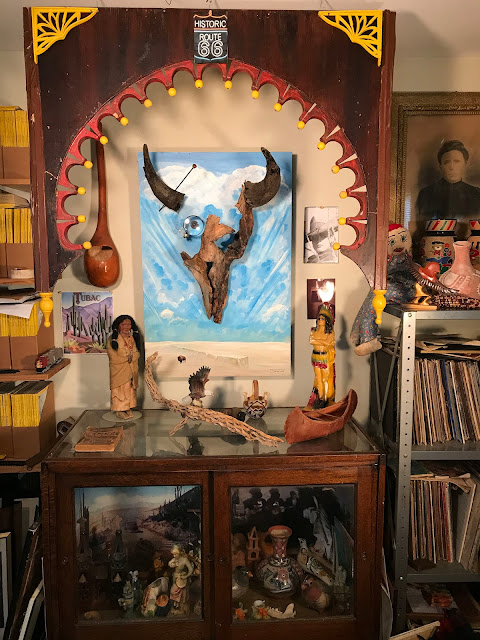.jpg) |
| Detail from “Origin of the Hattieville Bison” |
Almost all of my father’s art that I’ve presented so far have been oil paintings (except for one with acrylic and a couple of sketches). Oil painting is Dad’s preferred medium and comprises the majority of his work.
Today’s presentation, in contrast, shares two pieces with three-dimensional elements, both created within the last eleven years. Both were inspired by objects he collected while taking walks along the several curves the Arkansas River makes between Little Rock and North Little Rock. From its banks he has collected rocks, driftwood, and plants such as trumpet vines. Both works featured below were also inspired by the bio-evolutionary and geological processes on Earth.
Evolution of a Stone
At some point, Dad decided to change the title to “Evolution of a Stone,” an idea spurred by observing a row of fossils side-by-side, perhaps from the same location but from different periods of time. He imagined the art piece developing naturally from a stone along the river to the eventual finished prosthetic over time, as a parallel to how fossils arrive at their current state over an expanse of time and change.
Origin of the Hattieville Bison
The idea for the painting arose at about the moment Dad picked up the driftwood. He was influenced by Georgia O’Keefe, who had painted numerous works of horned skulls against the sky. Dad decided to use a similar background scene, including an ancient wall from an earlier civilization. The diagonal lines rising from the ground express a rush of natural debris created by an intense event. “Maybe a meteor hit the earth,” says Dad. “Who knows?”
He incorporated with the driftwood some real, “raw” bison horns he found online, so that the animal was manifest in the artwork not as a painting but as a 3-D element. He attached a spring to the back of the left horn to stabilize it in case it got bumped. The right side wasn’t as easy to adjust, so it has no spring.
A magnifying glass with its handle removed and the accompanying lens frames from loupes (often used in medical fields) accentuate the artificial elephant eye. Together, they symbolize the real evolution of the bison over time (implied by the incomplete nature of the “skull” structure, with space for where the eye socket would have been). The image of the bison on the lower left of the painting is not part of the painting, but a sticker that Dad found and liked!
One interesting afterword to the creation of this work: One morning, Dad walked into his large shed where he often does his paintings. He noticed that the sunrays coming in from a small, high window happened to be shining directly onto the small lenses, focusing the light onto the painting with such precision that he feared a fire risk. The angle of the sunlight on that very morning, paired with the ratio of distances between the window, the lenses, and the painting, happened to be just enough to cause a laser of focused sunlight. Just to be safe, he removed the lenses. He left the larger magnifying glass lens intact, because the angle/ratios were not close to being a risk.
Here’s the work as it is currently displayed in Dad’s backyard studio:
Among the many objects in view is a large wooden and glass case that belonged to my great grandmother, Ada Story Voss, which she called Zoo. Many of my Dad’s immediate relatives from and near his generation likely have memories of this Zoo. Dad remembers that it was always in Mama Voss’ living room, on the left side from the front entry. He saw it every time he visited her, across a large span of his life, and kids especially enjoyed looking at its contents. Mama Voss kept many trinkets inside, including objects given to her by family members visiting from California: Native American pottery, wooden animals, and her own artistic presentations of various and sundry objects. Dad remembers a similar, even larger cabinet in Mama Voss’ bedroom.
Most of the contents of Dad’s own Zoo today are items that he has purchased over the years, but a few of its items are from Mama Voss’ collection, which was scattered among various relatives after her death. The ones Dad received include a couple of her perfume bottles and the Native American Indian Chief statue atop Dad’s Zoo (to the right of an Indian doll he found at a thrift store). The statue came from the cabinet in Mama Voss’ bedroom.
To the right of the painting hangs a very old photograph of my great-great grandmother (Mama Voss’ mother), Bulah Leach Story, who died in 1908. It was displayed on a wall in Mama Voss’ bedroom. We really don’t know for sure how her first name was spelled, but it’s “Bulah” on her gravestone, which omits her middle name.
| Copyright © 2023 by André Duvall & Billy Charles Duvall |



Bulah Leach Story was my mother’s mother’s mother. Reading the image of her tombstone in Walnut Grove Cemetery, which André sent me, reminded me that she died (at age 37) just a bit over nine months after my mother was born. I hope Bulah felt up to holding my mother during those months of 1908. I’ll believe that she did.
ReplyDeleteThank you, André and Billy Charles, for including these maternal memories in this installment of “Father’s Art.” They’re inherently pertinent to art that explores the mysteries of origins and evolution.